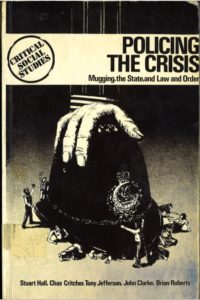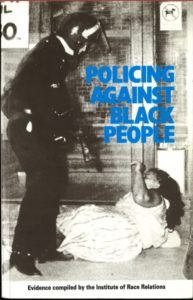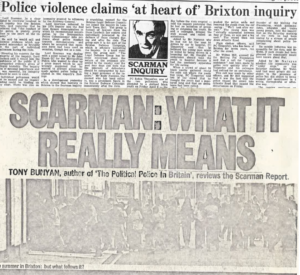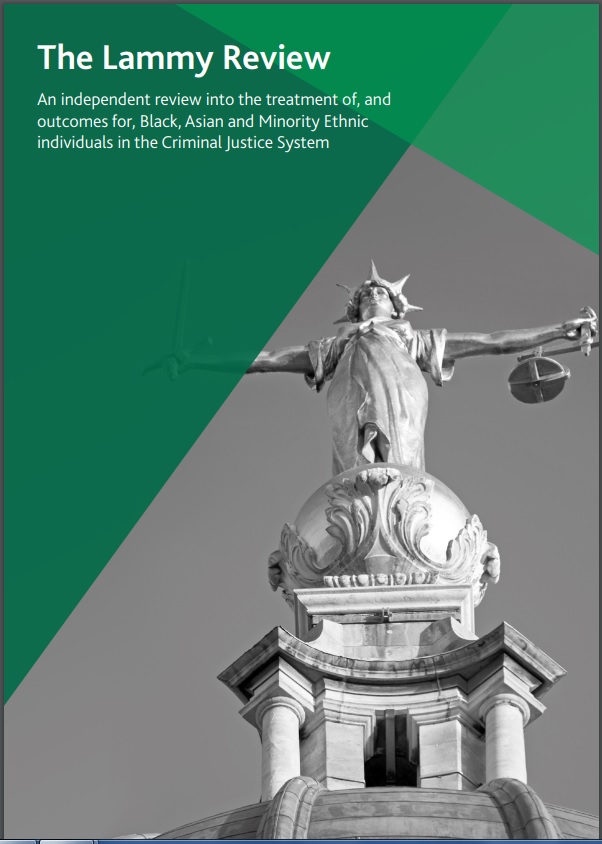Institutional racism is not mentioned in David Lammy’s important review of the over-representation of BAME people within the criminal justice system. The IRR tries to understand why.
UK prisons are at breaking point. Since August, there have been at least four outbreaks of serious disorder, at HMP Birmingham, The Mount Prison (Hertfordshire), Erlestoke Prison (Wiltshire) and HMP Haverigg (Cumbria). The UK incarcerates more people (by percentage of population) than any other country in the EU. The total prison population in England and Wales today stands at 86, 413, with BAME men and women making up 25 per cent of all prisoners and over 40 per cent of young people in custody from a BAME background. A shocking snapshot of the full extent of BAME over-representation in the Criminal Justice System (CJS) is provided by David Lammy, MP for Tottenham North in an independent review into the CPS, the courts system, prisons, young offender institutions, the Probation Board, the Probation Service and Youth Offending Teams. Commissioned by Conservative prime ministers David Cameron and Theresa May, Lammy was given access to the resources, data and information held by the CJS and tasked with coming up with solutions to reduce the proportion of BAME offenders within it. One statistic among many documented in this report jumps out. ‘The odds for receiving a prison sentence for a drug offence is around 240% higher for BAME offenders, compared to White offenders.’ It is such stark figures that have led organisations dealing with the fallout of racial injustice in the criminal justice system to welcome this report, with twenty-seven leading justice campaigners and organisations, including the Howard League for Penal Reform, the Runnymede Trust, the Association of Mental Health Providers, the Prison Reform Trust, NACRO and the Zahid Mubrek Trust, calling on the government to ‘fully support Lammy’s recommendations’. For, as Lammy warns, these ‘disproportionate numbers represent wasted lives, a source of anger and mistrust and a significant cost to the taxpayer’.
Problematic terms of reference
Lammy, who was advised by a panel of experts, carried out his review over a period of eighteen months, taking evidence from over 300 organisations and visiting many other jurisdictions including the US and New Zealand. The final report contains thirty-five recommendations aimed at improving on ‘fundamental principles of trust, fairness and responsibility’ so as to combat racial and ethnic disparities within the system. But a major independent report like this on such a crucial issue is not just the sum of its recommendations. It should also have provided, even if implicitly, an analysis and diagnosis of the causes of disproportionality – i.e. the structures and institutions which, if unaltered, reproduce racism. But such institutional racism is not mentioned in the report at all, although institutional racism was the definitive finding in Sir William Macpherson’s 1999 watershed report into the policing of the death of Stephen Lawrence, and no report into racism should go back on that finding.

Perhaps Lammy was prevented from addressing institutional racism, as one factor explaining BAME overrepresentation in the CJS, by the restrictive terms of reference he was given by the government – an investigation into ‘the treatment of, and outcomes for, Black, Asian and Minority Ethnic individuals’ in the Criminal Justice System (emphasis added). For this, by its very nature, omits from interrogation the processes that give rise to discrimination and over-representation of BAME individuals in the criminal justice system in the first place.
Shortly after the report was published, Richard Garside of the Centre for Crime and Justice Studies asked quite legitimately during a Spectator podcast debate on BAME disproportionality within the CJS why, when there was no evidence that black people are more criminal than white, they are far more likely to be criminalised. Surely, it is not controversial to point this out? The racialisation of crime by the media and the fact that structures and procedures of the police and the prosecution services target and criminalise BAME people have a long history. The IRR said as much back in 1979 in its evidence to the Royal Commission on Criminal Procedure as did Stuart Hall et al in the landmark 1978 study Policing the Crisis.
Lammy does not re-visit such controversial areas; instead, concentrating on the immediate causes of disproportionality. Hence, while acknowledging that the over-representation of BAME individuals within the CJS is inequitable, in and of itself, he does not centre his discussion on structures and processes that might cause such inequity. His analysis focuses instead on ‘unintended bias’ and ‘prejudice’ in individual decision-making which he sees as the main ‘barrier’ to ‘fair treatment’. (More later)

Current laws and practices that target BAME communities, the culture of policing and an institutional logic within police operations that leads to discrimination and/or racism are not the subject of this report. The targeting of BAME communities for intensive forms of policing and surveillance, the disproportionate use of force by the police on young Black males (leading to deaths in custody), the use of anti-terrorist laws and anti-radicalisation measures to bring a growing array of young Muslims, who have committed no crime, under the surveillance of the criminal justice system for behaviour alone, the governmental failure to provide Gypsy and Traveller sites leading to the criminalisation of a way of life, the racialisation of the gangs issue by the media and the subsequent incorporation of racist presumptions about ‘gang affiliations’ into the Metropolitan police’s Gang Matrix database, as well as the issue of the human algorithms used in data collection, are not placed at the heart of the report’s discussion of disproportionality.
When it comes to BAME individuals, Lammy repeatedly references ‘barriers’ to trust, ‘grievances over policing tactics’ and the development of an ‘us and them’ situation amongst BAME youth, as obstacles to reform. So while he genuinely wants BAME communities to have more confidence and trust in the CJS, recommending the introduction of a number of fairness and confidence measures, he does not acknowledge that institutional racism in policing, and the continuation of the racial stereotyping that informs such policing into the CJS, are fundamental sources of the mistrust.
Acknowledging specific areas of concern
However, specific policing measures, such as stop and search, the joint enterprise laws and the Metropolitan police Gang Matrix are flagged up in the report, a testimony to the hard work of campaigners in these areas. Although such measures are not discussed by Lammy within the long history of racially discriminatory policing, and racialised gang narratives are not acknowledged (he mentions rather abstrusely a ‘settled narrative’ around gangs), the fact that they are flagged up at all may help to increase the space from which researchers and campaigners can advocate more effectively. The importance of the Mayor of London’s review of the Trident Matrix is acknowledged and the CPS is encouraged to review its guidelines on joint enterprise prosecutions.
What are the causes of disproportionality?
Despite the limitations already acknowledged in the review’s terms of reference, Lammy did have the chance to make at least passing reference to structural issues and processes of criminalisation within his introduction. For here, he does address a number of factors that may give rise to disproportionality – including poverty, one-parent families, school exclusions – but not, it would seem, institutional racism. While many organisations working with young people gave evidence to the inquiry, an absence of the youth voice, or an acknowledgement of their perspectives in their own words, within the actual pages of the report is a severe lack. Young people caught up in the criminal justice system may well feel their lives have been shaped by racism, but Lammy identifies ‘troubled family relationships’, ‘mental health’ ‘learning difficulties’, ‘high reoffending rates among some BAME groups’, the failure of the youth justice system to effect parenting orders, as the more important factors contributing to over-representation of young BAME people in the system, as well as a ‘desire to rebel rather than reform’.
Back to ‘unintended bias’ and back to Scarman
Having failed to mention institutional racism in the body of the report, Lammy identifies, in his conclusion, three forms of prejudice – ‘overt, covert and unconscious’ – as fault lines within the CJS. Many newspapers flagged up issues of ‘racial bias’ in reporting the publication of the Lammy review, but there is but one reference to racial bias in the report, where Lammy much prefers to work with phrases like ‘unintended bias’, ‘unconscious’ or ‘implicit bias’. Bias is a euphemism for prejudice, and it is unconscious individual prejudices that are, in the final analysis, the subject of this report. If Lammy had even once used the term ‘collective bias’, it might have at least taken us back to some degree, to Macpherson’s (1999) definition of institutional racism as a ‘collective failure’. But instead, it reads in this report very much as though we are back to the concepts and frameworks used by Lord Scarman, as far back as the early 1980s, in his report into the causes of the 1981 Brixton ‘riots’.

Scarman refused to acknowledge that there was systematic racial injustice in the UK, preferring the vague term ‘disadvantage’ which attributed no cause, and accepted only the socio-psychological view that some police officers could manifest prejudice on the street – the rotten apple theory of policing. Racism for Scarman was in the mind – attitudes and irrational beliefs on both sides of the racial divide. He was even-handed in his findings! There is also in Lammy’s report this kind of even-handedness. If the perception that the CJS fails to provide ‘fair treatment’ and ‘promote diversity in different ways’ is a problem for him, so too is a tendency within BAME youth to adopt a ‘them and us’ attitude, which means offenders are less likely to respect the rule of law and inclined not to ‘respect rules in custody’. By using phrases like a ‘desire to rebel rather than reform’ and identifying a failure of BAME individuals to ‘take responsibility for their own lives’, Lammy could be used – by those on the Right – to argue that the disproportionate punishment of BAME youth could be attributed to a cultural tendency towards rebellion.
David Lammy is clearly as anxious as anyone else to reform the CJS. Many of his recommendations if implemented could certainly go some way in reducing the BAME prison population. But until there is real racial justice in this country, until laws, policies, and procedures that confirm the racial stereotyping of BAME offenders and institutionalise racism within the CJS, are dismantled, trust could remain elusive. David Lammy MP knows more than most about the rage that builds up within BAME communities when justice is denied.
Emeritus Professor Lee Bridges will be examining the recommendations in detail in a future article for IRR News.


I agree that David Lammy being prevented by the terms of reference to look into institutional racism is most unfortunate to say the least. In my view, the race inequalities in the field of ‘mental health’ (over-representation of black people diagnosed as ‘schizophrenic’, sectioned etc. ) about which much has been written, resembles very much the situation in the criminal justice system – and I think institutional racism is largely to blame in both instances. Although David Lammy’s proposals may help a little if acted upon I do not think the grave injustices in the MH system and in the way the CJS works can be tackled until the institution issues are addressed and I think it would been most useful if both MH and Criminal justice systems are considered together.
I agree with the above comment but think it goes wider. At the Centre for Crime and Justice Studies we have been working on what we call the ‘ethnic penalty’ that can be found across society – particularly for young black men. The data is quite striking across the board from early years, to education, employment, income, and health including mental health. The justice system is not exceptional in the outcomes and processing of, in particular, young black men, but just forms one instance of discrimination experienced across broader society. Of course being in the justice system is a very harmful experience so those leaving are usually always in a worse shape coming out than when they went in. Because of the limited remit of the Lammy Review it was inevitable that he was not going to get to the bottom of the issue, name what should have been named and analysed a structural and social process across the society in which the justice system is embedded and determines its population and outcomes. At heart this is not about issues of ‘trust’ or grievance’ but a systematic discrimination of which the justice system is part.